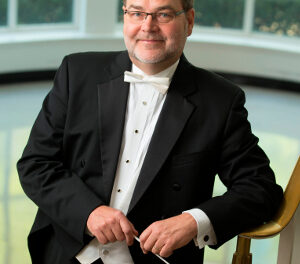I’m sure that many people attended the Duke Symphony Orchestra concert in Baldwin Auditorium on October 8, 2003, with a combination of anticipation and incredulity – the former because of the rare chance to hear Bruckner’s Fourth Symphony live, and the latter because the work is a daunting, difficult one even for a major professional orchestra, much less for a campus-based student/community group.
Bruckner’s Symphony No. 4 in E flat Major (the Romantic), is the composer’s most accessible symphony, its thrilling climaxes, haunting themes and majestic grandeur making it easy for the listener to be swept away. But a successful performance requires the conquering of relentlessly punishing passages for solo and massed brass, tricky dynamic changes and sudden rhythmic shifts. Also, the conductor must have a firm grasp of the overall architecture of each movement to keep all the little sections together as a whole.
I began to worry about the orchestra’s chances for success during its performance of the program’s opening work, Schubert’s Symphony No. 8 (the Unfinished). Although conductor Harry Davidson created appropriate mood in the quiet moments and coaxed some beautiful tone from the cellos, the tempos in both movements were too relaxed and careful to sustain momentum. The louder, fuller moments were sluggish and heavy, with muggy strings and loud brass. This Schubert had no floating grace.
Things began to improve, however, with two short pieces for violin and orchestra by Mozart. Davidson had an appropriately delicate touch with the accompaniment to Eric Pritchard’s solos. Usually encountered as the first violinist of the Ciompi Quartet, Prichard employed his signature sweet tone for a wistful rendering of the Adagio in E Major, K. 261. Pritchard used the cadenza to add some perky flourishes to his otherwise serenely focused stance. For the succeeding Rondo in C Major, K. 373, Davidson indicated the joy of the music through his little bounces on the podium. Even though the tempo and the character of the piece would have allowed a bolder approach and a bigger tone, Prichard kept his playing demurely reigned in, permitting a few jaunty strokes at the piece’s conclusion.
Whatever misgivings I still might have had during intermission were instantly swept away within the first few measures of the Bruckner. Davidson obviously knows and relishes this piece and he confidently led his 93 players in an amazingly satisfying performance. Yes, there were horn blats here and there, and several stretches of string intonation and co-ordination difficulties. But these were easily forgiven because of the intensely felt, beautifully paced interpretation.
The players gave evidence of extensive rehearsal as they precisely responded to Davidson’s every cue, whether building a well-modulated climax or making a sharp cutoff. It was a pleasure to watch Davidson’s body language reflect the many moods of the music, never just for show but always deeply rooted in the glories of the score.
The first movement had wonderful tension, carrying the music along through the several climaxes, with smooth transitions in tempo. Davidson elicited many soaring passages in the second movement, bringing it down to a breath-taking hush at the end.
The third movement was perhaps the most successful, with the brass imitating hunting horns, the woodwinds sparkling in their folk melodies and everyone displaying crisp precision.
Only in the fourth movement did Davidson lose a bit of control. Bruckner doesn’t help by having too many climatic moments (after so many in the previous movements), which constantly build up and fall back, alternating the heaven-storming with the bucolic in too many small bits. Nonetheless, there was great atmosphere and impressive size of sound, Davidson making the most of the lush expansive themes.
A measure of the performance’s success was the rapt attention from the audience, which included a number of students. The hour-long work kept the audience involved, moving them to strong applause and cheering at its conclusion. Davidson is to be congratulated for daring to program such a challenging work for a non-profession orchestra. For my money (and the concert was free), the glass was more than half-full, the less-than-perfect passages detracting not all from the overall experience.











